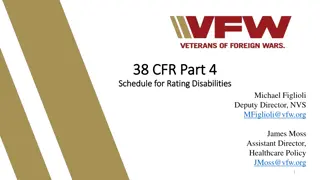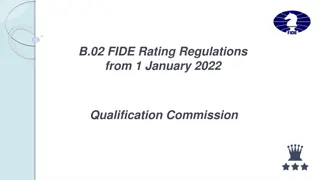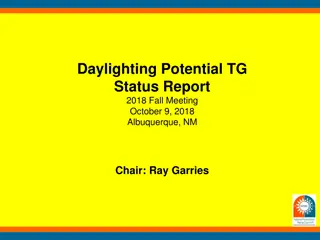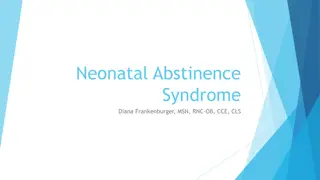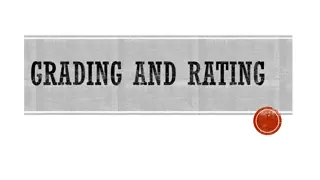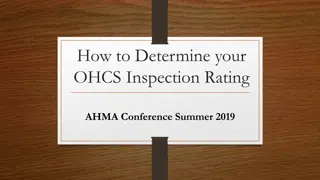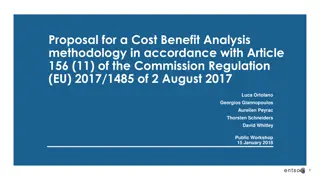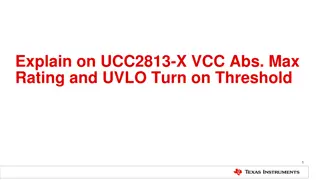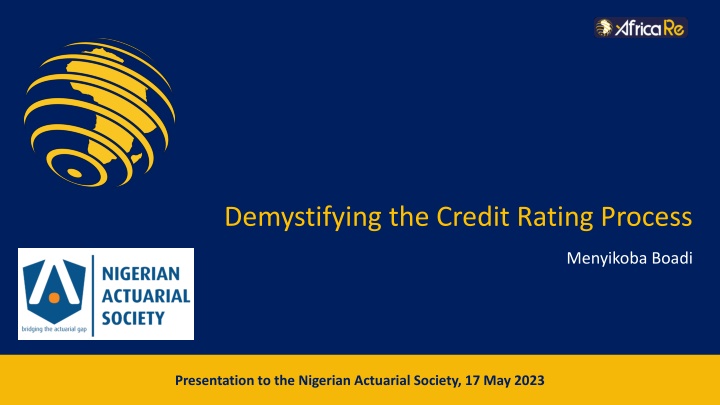
Credit Rating Process and its Significance
Explore the intricacies of credit rating through this informative presentation. Learn about the evaluation process, historical background of rating companies, and reasons to consider having a credit rating. Discover key insights on A.M. Best's rating methodology and tips for achieving a favorable credit rating.
Download Presentation

Please find below an Image/Link to download the presentation.
The content on the website is provided AS IS for your information and personal use only. It may not be sold, licensed, or shared on other websites without obtaining consent from the author. If you encounter any issues during the download, it is possible that the publisher has removed the file from their server.
You are allowed to download the files provided on this website for personal or commercial use, subject to the condition that they are used lawfully. All files are the property of their respective owners.
The content on the website is provided AS IS for your information and personal use only. It may not be sold, licensed, or shared on other websites without obtaining consent from the author.
E N D
Presentation Transcript
Demystifying the Credit Rating Process Menyikoba Boadi Presentation to the Nigerian Actuarial Society, 17 May 2023
Agenda Introduction Credit Rating Process A M Best Credit Rating methodology Rating methodology simulation Tips on getting a good rating Questions 2 NAS Lecture - Credit Rating Process - 17 May 2023
Introduction A credit rating is an evaluation of a company s ability to meet its ongoing financial obligations. https://web.ambest.com/ An unbiased and independent opinion of the company. https://www.spglobal.com/ratings/en/ The evaluation is done via a qualitative and quantitative assessment. Typically carried out by credit rating agencies. https://www.fitchratings.com/ https://www.moodys.com/ https://gcrratings.com/ 3 NAS Lecture - Credit Rating Process - 17 May 2023
Which rating company is the oldest? NAS LECTURE - CREDIT RATING PROCESS - 17 MAY 2023 4 Start presenting to display the poll results on this slide.
History of Credit Rating Agencies S&P Global Moody s GCR Ratings 1860 1909 1995 A M Best Fitch Ratings 1899 1913 5 NAS Lecture - Credit Rating Process - 17 May 2023
Why consider having a Credit Rating? It serves as a global benchmarking tool Gives confidence to business partners Marketing tool Motivation for growth 6 NAS Lecture - Credit Rating Process - 17 May 2023
Credit Rating Process 1. Public and proprietary financial information and data on the company are compiled 2. Qualitative and quantitative measures are used to evaluate the company s financial health 4. They submit their findings and report to rating committee 3. Rating analysts meet with senior management of the company 6. Assigned rating is notified to the company being rated and then published 5. Rating committee discuss the report and assign rating 7. Continuous monitoring by continually analysing the company s creditworthiness 7 NAS Lecture - Credit Rating Process - 17 May 2023
A M Bests Rating Process Maximum +2 Foundational Building Blocks Country Risk Published Issuer Credit Rating Balance Sheet Strength Operating Performance Enterprise Risk Management Comprehensive Adjustment Rating Lift/Drag Business Profile (+2 to -2) Baseline (+2 to -3) (+1 to -4) (+1 to -1) Source: A M Best (https://www3.ambest.com/ambv/ratingmethodology/) 8 NAS Lecture - Credit Rating Process - 17 May 2023
A M Bests Building Block Approach Balance Sheet Strength Operating Performance Enterprise Risk Management Business Profile Assessment Assessment Assessment Assessment Very Strong +2 Strongest Very Favorable +2 Very Strong +1 Strong +1 Very Strong Favorable +1 Appropriate 0 Adequate 0 Strong Neutral 0 Marginal -1 Marginal -1 Adequate Limited -1 Weak -2 Weak -2 Weak Very Weak -3/4 Very Limited -2 Very Weak -3 Very Weak Source: A M Best (https://www3.ambest.com/ambv/ratingmethodology/) 9 NAS Lecture - Credit Rating Process - 17 May 2023
Bests Rating Building Block I Balance Sheet Strength Maximum +2 Country Risk Published Issuer Credit Rating Balance Sheet Strength Operating Performance Enterprise Risk Management Comprehensive Adjustment Rating Lift/Drag Business Profile (+2 to -2) Baseline (+2 to -3) (+1 to -4) (+1 to -1) Source: A M Best (https://www3.ambest.com/ambv/ratingmethodology/) 10 NAS Lecture - Credit Rating Process - 17 May 2023
Bests Rating Building Block I Balance Sheet Strength One component in the assessment is the Capital Adequacy Ratio (CAR) A M Best use a stochastic based capital model to determine the CAR for the company. This model is called the BCAR (Best s Capital Adequacy Ratio) model It is currently excel based. Required data is collected from the company using supplementary rating questionnaires (SRQs) Available Capital Required Capital Available Capital ???R score = 100 11 NAS Lecture - Credit Rating Process - 17 May 2023
Bests Capital Adequacy Ratio (BCAR) model Capital charges on lines of business written Gross and net reserves risk charges Potential Catastrophe losses Reported Capital Available Capital Adjustments to reported capital = Net Required Capital + + Business Risk - Covariance Adjustment + Insurance Risk + Asset Risk Catastrophe Risk Off balance sheet items Diversification benefit (Square root rule covariance calculation) Fixed Income Securities Equities Interest Rate Risk Credit Risk Source: A M Best (https://www3.ambest.com/ambv/ratingmethodology/) 12 NAS Lecture - Credit Rating Process - 17 May 2023
Bests Capital Adequacy Ratio (BCAR) Capital charges on lines of business written Gross and net reserves risk charges Potential Catastrophe losses Reported Capital Available Capital Adjustments to reported capital = Net Required Capital + + Business Risk - Covariance Adjustment + Insurance Risk + Asset Risk Catastrophe Risk Diversification benefit (Square root rule covariance calculation) Off balance sheet items Fixed Income Securities Equities Interest Rate Risk Credit Risk Available Capital Net Required Capital Available Capital ???R score = 100 Source: A M Best (https://www3.ambest.com/ambv/ratingmethodology/) 13 NAS Lecture - Credit Rating Process - 17 May 2023
Company XYZ BCAR model results Var 95.0 Var 99.0 Var 99.5 Var 99.6 Var 99.8 Available Capital 725,000 725,000 725,000 725,000 725,000 Asset Risk: Fixed Income Securities Risk 62,400 65,340 68,475 70,587 75,875 Equity Securities Risk 101,540 114,233 128,512 144,576 162,647 Interest Rate Risk 6,275 7,059 7,942 8,935 10,051 Credit Risk 54,358 61,153 68,797 77,396 87,071 Total Asset Risk 224,573 247,785 273,725 301,493 335,645 Underwriting Risk: Net Loss & LAE Reserve Risk 125,935 141,677 159,386 179,310 201,724 Net Premium Risk 129,668 145,877 164,111 184,625 207,703 Total Underwriting Risk 255,603 287,553 323,498 363,935 409,427 Business Risk 55 55 55 55 55 Net Catastrophe PML 1,800 18,570 25,750 45,887 97,510 Gross Required Capital 482,031 553,963 623,028 711,370 842,636 Less: Covariance Adjustment 248,246 285,291 320,859 366,356 433,958 Net Required Capital 233,785 268,672 302,168 345,015 408,679 Adjusted BCAR 68% 63% 58% 52% 44% **Results are based on a fictional insurance company 14 NAS Lecture - Credit Rating Process - 17 May 2023
Bests Rating Building Block I Balance Sheet Assessment VaR Confidence Level (%) BCAR Score BCAR Assessment Other aspects of the business operations assessed are Reinsurance dependence and quality Asset-Liability Management Liquidity management Adequacy of reserves Stress tests Quality of capital Any internal capital models 99.6 >25 at 99.6 Strongest 99.6 >10 at 99.6 & 25 at 99.6 Very Strong Balance Sheet Strength 99.5 >0 at 99.5 & 10 at 99.6 Strong 99 >0 at 99 & 0 at 99.5 Adequate 95 >0 at 95 & 0 at 99 Weak 95 0 at 95 Very Weak Key Characteristics Assessment Strongest BCAR score with a demonstrated pattern of stability Strongest Very Strong BCAR score with a demonstrated pattern of stability Very Strong Strong BCAR score with a demonstrated pattern of stability Strong Adequate BCAR score that has been relatively stable Adequate Weak BCAR score with a demonstrated pattern of volatility Weak Very Weak BCAR score with a demonstrated pattern of volatility Very Weak Source: A M Best (https://www3.ambest.com/ambv/ratingmethodology/) 15 NAS Lecture - Credit Rating Process - 17 May 2023
Overall Balance Sheet Assessment The final aspect incorporates country risk (country-specific risk factors that could adversely affect an insurer s ability to meet its financial obligations). This along with the B/S assessment determines the baseline issuer credit rating (ICR) Country Risk Tier (CRT) CRT-1 CRT-2 CRT-3 CRT-4 CRT-5 Balance Sheet Assessment Strongest a+/a a+/a a/a- a-/bbb+ bbb+/bbb Very Strong a/a- a/a- a-/bbb+ bbb+/bbb bbb/bbb- Strong a-/bbb+ a-/bbb+ bbb+/bbb/bbb- bbb/bbb-/bb+ bbb-/bb+/bb Adequate bbb+/bbb/bbb- bbb+/bbb/bbb- bbb-/bb+/bb bb+/bb/bb- bb/bb-/b+ Weak bb+/bb/bb- bb+/bb/bb- bb-/b+/b b+/b/b- b/b-/ccc+ Very Weak b+ and below b+ and below b- and below ccc+ and below ccc and below https://www3.ambest.com/ratings/cr/crisk.aspx - more information on CRT and the list of countries 16 NAS Lecture - Credit Rating Process - 17 May 2023
Bests Rating Building Block II Operating Performance Maximum +2 Country Risk Published Issuer Credit Rating Balance Sheet Strength Operating Performance Enterprise Risk Management Comprehensive Adjustment Rating Lift/Drag Business Profile (+2 to -2) Baseline (+2 to -3) (+1 to -4) (+1 to -1) Source: A M Best (https://www3.ambest.com/ambv/ratingmethodology/) 17 NAS Lecture - Credit Rating Process - 17 May 2023
Bests Rating Building Block II Operating Performance Viewed as a leading indicator of future balance sheet strength and long-term financial stability. Focuses on the stability, diversity and sustainability of the company s earnings sources and the interaction between earnings and liabilities. Considers some key financial metrics Return on Capital Pre tax income Combined Ratio Expense Ratio Loss Ratio Return on Assets 18 NAS Lecture - Credit Rating Process - 17 May 2023
Bests Rating Building Block II Operating Performance HistoricalPerformance Trends over past years High volatility in key metrics would give below adequate assessment. Future Performance Business plans and projections Below adequate assessment if there is uncertainty in the plans and poor results expected. Operating Performance Assessment Key Characteristics Very Strong +2 Trends are positive and performance is exceptionally strong and consistent. Strong +1 Trends are neutral or slightly positive and performance is strong and consistent. Adequate 0 Trends and performance are neutral. Trends have been inconsistent and neutral or slightly negative and performance is strong and consistent. Marginal -1 Weak -2 Trends have been poor and performance is expected to be poor. Very Weak -3 Trends have been very poor and performance is expected to be very poor. Source: A M Best (https://www3.ambest.com/ambv/ratingmethodology/) 19 NAS Lecture - Credit Rating Process - 17 May 2023
Bests Rating Building Block III Business Profile Maximum +2 Country Risk Published Issuer Credit Rating Balance Sheet Strength Operating Performance Enterprise Risk Management Comprehensive Adjustment Rating Lift/Drag Business Profile (+2 to -2) Baseline (+2 to -3) (+1 to -4) (+1 to -1) Source: A M Best (https://www3.ambest.com/ambv/ratingmethodology/) 20 NAS Lecture - Credit Rating Process - 17 May 2023
Bests Rating Building Block III Business Profile Highly qualitative element of the rating evaluation process. It includes an evaluation of the following factors: Market position Degree of competition Distribution channels Pricing sophistication and data quality Management quality Product/Geographic concentration Product risk Regulatory, event, market, and country risks Source: A M Best (https://www3.ambest.com/ambv/ratingmethodology/) 21 NAS Lecture - Credit Rating Process - 17 May 2023
Bests Rating Building Block III Business Profile Innovation assessment (Confidential) Qualitative assessment Leadership Utilization of technology Utilization of data Competitive advantage in chosen markets Business Profile Culture Resources Processes and Structure Assessment Key Characteristics Unquestionable as the market leader and management capabilities are very strong. Very Favorable +2 Market leader with strong management team. Favorable +1 Competitive in chosen markets but not a market leader. Neutral 0 Undifferentiated and faces high/increasing competition. Limited -1 Weak data management, high-risk products, limited geographic diversity. Very Limited -2 Source: A M Best (https://www3.ambest.com/ambv/ratingmethodology/) 22 NAS Lecture - Credit Rating Process - 17 May 2023
Bests Rating Building Block IV Enterprise Risk Management Maximum +2 Country Risk Published Issuer Credit Rating Balance Sheet Strength Operating Performance Enterprise Risk Management Comprehensive Adjustment Rating Lift/Drag Business Profile (+2 to -2) Baseline (+2 to -3) (+1 to -4) (+1 to -1) Source: A M Best (https://www3.ambest.com/ambv/ratingmethodology/) 23 NAS Lecture - Credit Rating Process - 17 May 2023
Bests Rating Building Block IV Enterprise Risk Management Governance and culture Qualitative assessment Assessing the capability of the risk management framework Demonstrate the benefits of ERM to the company s operations Risk identification and reporting Risk mitigation and controls Risk appetite and tolerance Assessment Key Characteristics Framework is embedded and results are evident in a prudent and stable level of net required capital and successful performance over the long term. Very Strong +1 ERM framework is developed and risk management capabilities are well aligned to the risk profile of the company. Appropriate 0 Risk management capabilities show some weakness in key areas. Marginal -1 Weak -2 Risk management capabilities are not aligned to the risk profile of the company Very Weak -3/4 Source: A M Best (https://www3.ambest.com/ambv/ratingmethodology/) 24 NAS Lecture - Credit Rating Process - 17 May 2023
Bests Rating Building Block V Comprehensive Adjustment Maximum +2 Country Risk Published Issuer Credit Rating Balance Sheet Strength Operating Performance Enterprise Risk Management Comprehensive Adjustment Rating Lift/Drag Business Profile (+2 to -2) Baseline (+2 to -3) (+1 to -4) (+1 to -1) Source: A M Best (https://www3.ambest.com/ambv/ratingmethodology/) 25 NAS Lecture - Credit Rating Process - 17 May 2023
Bests Rating Building Block V Comprehensive Adjustment Positive => +1 Most of the credit ratings published are not adjusted (0). The company has uncommon strengths that exceed what has been captured throughout the rating process. The company s strengths and weaknesses have been accurately captured throughout the rating process. Negative => -1 The company has uncommon strengths that exceed what has been captured throughout the rating process. Source: A M Best (https://www3.ambest.com/ambv/ratingmethodology/) Made when the company being reviewed has an uncommon strength or weakness that exceeds (or is less than) what has been captured through the rating process. 26 NAS Lecture - Credit Rating Process - 17 May 2023
A M Best Rating Building Blocks Maximum +2 Country Risk Published Issuer Credit Rating Balance Sheet Strength Operating Performance Enterprise Risk Management Comprehensive Adjustment Rating Lift/Drag Business Profile (+2 to -2) Baseline (+2 to -3) (+1 to -4) (+1 to -1) Source: A M Best (https://www3.ambest.com/ambv/ratingmethodology/) 27 NAS Lecture - Credit Rating Process - 17 May 2023
Bests Credit Rating Rating Enhancement Lift -> +1 to +4 Neutral: No enhancement The company being rated either receives explicit support from the broader organization or is deemed materially important within the broader organization as demonstrated by its level of integration. The company being rated does not have explicit support from the broader organization and is not considered materially important within the organization. Drag -> -1 to -4 The company being rated is negatively impacted by its association with the weaker affiliates of the broader organization. Source: A M Best (https://www3.ambest.com/ambv/ratingmethodology/) 1. A rating enhancement / drag applies where there is a parent company to the company being rated. 2. The rating lift / drag assessment aims to capture any impact from the parent company that has not yet been captured up to this point in the process. 28 NAS Lecture - Credit Rating Process - 17 May 2023
Credit Rating Methodology Example VaR Confidence Level (%) BCAR Score BCAR Assessment Country Risk Tier (CRT) CRT-1 CRT-2 CRT-3 CRT-4 CRT-5 99.6 >25 at 99.6 Strongest Balance Sheet Assessment Strongest a+/a a+/a a/a- a-/bbb+ bbb+/bbb 99.6 >10 at 99.6 & 25 at 99.6 Very Strong Very Strong a/a- a/a- a-/bbb+ bbb+/bbb bbb/bbb- 99.5 >0 at 99.5 & 10 at 99.6 Strong bbb+/bbb/b bb- bbb/bbb- /bb+ Strong a-/bbb+ a-/bbb+ bbb-/bb+/bb 99 >0 at 99 & 0 at 99.5 Adequate bbb+/bbb/b bb- bbb+/bbb/b bb- 95 >0 at 95 & 0 at 99 Weak Adequate bbb-/bb+/bb bb+/bb/bb- bb/bb-/b+ 95 0 at 95 Very Weak Weak bb+/bb/bb- bb+/bb/bb- bb-/b+/b b+/b/b- b/b-/ccc+ b+ and below b+ and below ccc+ and below ccc and below Very Weak b- and below Country Risk Balance Sheet Strength Enterprise Risk Management Issuer Credit Rating Operating Performance Comprehensive Adjustment Rating Lift/Drag Business Profile Baseline +1 0 Very Strong & CRT 5 bb+ +1 0 Favourable n/a Appropriate Strong None Based on A M Best Credit Rating Methodology 29 NAS Lecture - Credit Rating Process - 17 May 2023
Credit Rating Methodology Example aaa, aa+ aa, aa- a+, a bbb+, bbb bb+, bb b+, b ccc+, ccc ccc-, cc ICR* a- bbb- bb- b- c FSR* A++ A+ A A- B++ B+ B B- C++ C+ C C- D *ICR = Issuer Credit Rating *FSR = Financial Stability Rating Country Risk Issuer Credit Rating Enterprise Risk Management Balance Sheet Strength Operating Performance Comprehensive Adjustment Business Profile Rating Enhancement +1 0 Baseline Strong & CRT 5 bb+ +1 0 Favourable bbb Appropriate bbb bbb n/a Strong bbb- None bbb Rating recommendation of bbb Based on A M Best Credit Rating Methodology 30 NAS Lecture - Credit Rating Process - 17 May 2023
A M Bests Rating Rating Outlook Positive Stable Negative The rating may be upgraded in the near term if there is improvement. The rating is unlikely to change in the near term. The rating may be downgraded in the near term if further there is further deterioration. Opinion on the future direction of the rated company. Source: A M Best (https://www3.ambest.com/ambv/ratingmethodology/) 31 NAS Lecture - Credit Rating Process - 17 May 2023
Tips for a good rating + Transparency + Adequate preparation and documentation + Show how risk management has prevented losses (from underwriting, investments, operational risk, etc) + Ensure there is enough capital to meet any expansion plans + Compliance with regulatory requirements and international best practice + Take note of rating drivers gives you indication of what could lead to an upgrade/downgrade - Don t respond to requests with insufficient data and no supporting explanation - Don t ignore requests or go silent on their requests and communication - Don t assume lack of documentation means processes don t exist - Don t hold back on providing as much information as possible to put the company in a positive light 32 NAS Lecture - Credit Rating Process - 17 May 2023
Questions? 33 NAS Lecture - Credit Rating Process - 17 May 2023
For additional information, please visit: http://www3.ambest.com/ambv/ratingmethodology/ 34 NAS Lecture - Credit Rating Process - 17 May 2023
Thank You 35 NAS LECTURE - CREDIT RATING PROCESS - 17 MAY 2023



